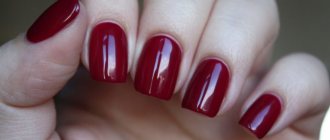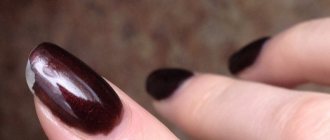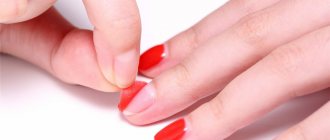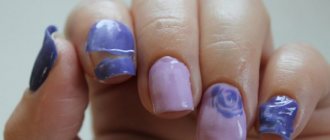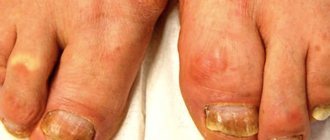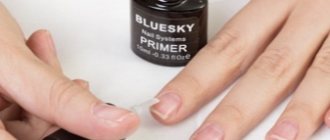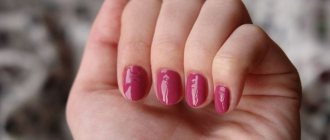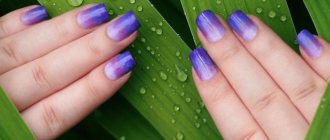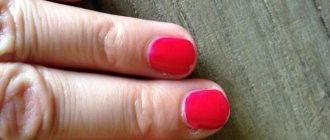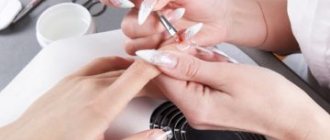Why does gel polish peel off?
First of all, it depends on the manicure procedure itself. The following questions are especially important.
- Has the cuticle area been treated thoroughly? (Is the shine removed with a buff?)
- Has the first layer of gel polish been applied to the dried nail plate?
- Have you used a primer?
- Is the free edge of the nail sealed? (Sometimes the free edge of the nail is missing or the fingertips overlap the nail - this happens when the client bites his nails or cuts the free edge to zero).
Other reasons may be:
- constant contact with water - washing dishes without gloves, frequent hand washing, working in aggressive environments leads to the absorption of moisture by the nail plates, which causes detachment of gel polish or biogel;
- peculiarity of the nail plate (rejection of foreign material on the nails - this is when the work of several different masters and different materials does not last for the indicated 2-3 weeks);
- excessive moisture on the skin of the hands (for example, often sweaty palms) - in this case, it is advisable to go over the nail plate with a primer twice and dry it thoroughly before applying gel polish).
Physiological reasons cannot be excluded:
- diseases of the nervous system or a stressful period in life;
- disruption of the immune system;
- diabetes;
- taking antibiotics;
- rehabilitation period after surgery;
- pregnancy, hormonal imbalances and menstrual periods (in the first days you should refrain from extensions and applying gel polish).
How to strengthen peeling nails at home
It is possible to strengthen peeling nails both in the salon and at home. If treatment is not necessary, take care of your nails by doing the following from time to time:
- Compresses with oils.
Thanks to oils, the nail plate is softened and saturated with necessary substances. Olive, castor, burdock, pine and cedar oils will be beneficial for it. By nourishing the nail plate, they strengthen it from the inside. It is preferable to do compresses before going to bed: wrap your nails with cotton pads with oil applied to them and place them in cosmetic gloves overnight. In the morning, you can wipe off the remaining oil and use hand cream.
- Rubbing in oil.
It is not always possible to make compresses. How else can you strengthen your nails so they don’t peel? You can rub the oil into the nail plate. Do this with light massage movements, repeating the procedure several times a day. Rubbing is very convenient to use, since it takes little time and the procedure can be done even during the work process.
Recommended articles on the topic:
- Medical hardware pedicure
- Curvature of the nail plate
- Removing an ingrown toenail and how to avoid it
- Massage.
It is very good to massage your hands and especially your fingers where the nails grow. By performing this procedure, you stimulate blood circulation and normalize the flow of nutrients to the nail plate.
- Sealing nails with wax.
This procedure helps the nails recover. Beeswax is usually used for sealing because it contains so many beneficial substances. Penetrating into the very structure of the nail and impregnating it, wax creates a protective layer. Due to this, the nails become practically impenetrable, nothing can have a destructive effect on them, so delamination stops.
- Paraffin therapy.
Another procedure similar to wax sealing. How to strengthen peeling nails with paraffin therapy? Nails are immersed for 30 seconds in cosmetic paraffin, previously melted and diluted with oils. This procedure allows you to fill the surface of a peeling nail and strengthen it. Repeating the dives about seven times, complete the procedure by wearing cosmetic gloves on your hands for 2-3 hours. The remaining paraffin can be rubbed into the nail plate. It is useful to carry out this procedure when cold weather sets in, because nails are afraid of low temperatures. Paraffin therapy promotes the supply of nutrients and improves blood circulation in the vessels.
- Nail baths.
Peeling nails do not need to be placed in baths often, since water, although it nourishes the nail structure, also softens it. But completely abandoning such a procedure is also not a solution to the situation: just do not use ingredients that are an aggressive environment for peeling nails. These include salt, soda and iodine. It’s better to take baths from herbal infusions with added oils a couple of times a month. This treatment will only benefit peeling nails.
If your nails are peeling, do not use all kinds of scrubs and polishing files to smooth the nail plate. This will only destroy its structure. Peeling and brittle nails should be trimmed to avoid injury.
Read material on the topic: Removing an ingrown toenail and how to avoid it
Types of gel polish peelings
Damage to the nail coating may include the following:
- the gel polish swells and then comes off in layers along the entire length of the nail;
- On square plates, whole pieces of varnish break off at the ends;
- detachment from the nail occurs in the cuticle area.
The pieces do not fly off immediately, but after a while after mechanical actions with the nail or when using water and hard sponges. When peeling of the varnish from the plate is observed after a few days, it can be assumed that the application technology is broken or there are health problems.
In the cabin
This is the heavy artillery for saving damaged nails. Here you can handle the lamination much faster.
1. IBX.Today, this is the most effective procedure that stops the delamination of nail plates. It is performed by the product of the same name from Famous Names. The two-phase preparation is absorbed into the nail under the influence of heat, like oil, and then polymerizes in a lamp, like a gel. The acrylates contained in the product replace broken keratin bonds, working like double-sided tape for the layers of the nail. In severe cases, a course of procedures will be required; in the case of a small lamination of the free edge, one will be enough. The procedure can be performed under gel polish; it improves the durability of artificial surfaces. The drug is not rejected even by capricious nails (like detachments), it does not need to be removed subsequently, and it is not visible on the nail plate.
2. Lamination of nails. This procedure was developed by the LCN brand and requires Boost Gel. A thin insoluble gel with a glossy finish is applied to prepared and cleaned legs of visible detachments. It creates a lens on the surface of the nail that protects against the harmful effects of the external environment. The drug can be applied as a base under varnish or gel polish coating. If the nails are very weakened or peeling scales are left behind, chips and detachments of the material are possible.
3. Japanese manicure. Perhaps this is the most natural way to deal with layering of the nail plate. A paste based on diatomaceous clay and powder containing natural beeswax are rubbed successively into the prepared nails using special leather buffs. As a result, the nails acquire a moist gloss, become stronger and denser, and stop flaking. There is no point in using this procedure under gel polish coating, but you can cover it with regular varnish.
The main thing is to find a good specialist. Find out how to recognize an incompetent manicurist in advance: 6 sure signs
Causes
There are many reasons why gel polish peels off the nail already on the second day after its application or, at most, a week later. And contrary to popular belief, the master is not always to blame for the premature peeling of the gel coating. All the reasons that lead to this problem can be divided into several large groups. Most often, gel polish peels off from a natural nail in the following cases:
- In case of serious health problems, gel polish falls off the nail plate within the first day after its application. If you have diseases such as diabetes, heart or kidney disease, as well as any types of surgical intervention, it is recommended to avoid this coating of marigolds. The same rule applies to taking antibiotics, as well as the period when the menstrual cycle begins. In all these cases, the gel polish will not stay on the nails for long and will begin to peel off from the nail plate after two days.
- Individual characteristics of the body, these include excessive sweating of the palms, too oily skin of the fingers, as well as thin and peeling nails. In all these cases, tight adhesion of the coating to the nail plate is not ensured, which means that the gel polish may begin to chip off both the base and the fixer. Therefore, it is very important to restore health to your nails, as well as get rid of excessive sweating and be sure to use a special degreaser.
- Using low-quality products or products from different manufacturers. Therefore, it is best to purchase primer, base, top coat and gel polish of the same brand. You should not try to save money on purchasing these components; it is better to choose products from well-known manufacturers.
- Violation of manicure technology. This includes incorrectly applying all products to the nail, ignoring the correct treatment of the cuticle, performing a trim manicure immediately before using gel polish, applying the base and the coating itself to the cuticle. So, if the end of the nails is not sealed, the coating comes off at their tips within a day after application.
- Applying a thick layer of product in the cuticle area is also the cause of this defect.
- Perform spa treatments the day before applying gel. This is especially true for various wraps of palms with oil-based mixtures, as well as the use of various masks. In these cases, the nail plates are too moist and greasy, and even the use of a degreaser will not help the base and gel polish adhere tightly to their surface.
- Failure to adhere to the drying time of the nails in the lamp. Not always masters, and especially girls who independently perform such a manicure at home, keep their nails in the lamp for the required time. As a result, the coating may not only peel off prematurely, but also a variety of bubbles and cracks may appear on it.
- Failure to remove the sticky layer from the surface of the nails is also a common cause of premature peeling of the gel coating from their surface.
- Excessively frequent contact with water and aggressive chemicals during the first 24 hours after a gel polish manicure. It often happens that the coating not only peels off from the surface of the nails, but also peels off as a film. This happens in cases where, within several hours after the end of the procedure, the nails have been in contact with water for a long time.
- Lack of professionalism of the specialist, as well as the desire to save time on the procedure. Sometimes, in order to perform a manicure as quickly as possible, some nail technicians ignore the use of any mandatory product, which as a result leads to poor-quality coating and its premature peeling.
But to preserve a beautiful manicure made with gel polish, it is not enough just to know about the reasons for the appearance of such a defect as its premature peeling off from the nail plate. You also need to know how to avoid this.
Problems with nails when gel polish peels off
These reasons include: 1. Thinning nails, prone to splitting. They can peel off along with the coating not because of errors in the application technique, but because they have this feature. Here we can advise you to perform a strengthening procedure, for example, with the IBX system, before applying gel polish.
2. Thin nails may not be natural, but due to the fact that the previous coating was removed mechanically (tearing off by hand) or by soaking and strong pressure from a pusher. This leads to the fact that the gel polish is removed along with a thin layer of the nail, leading to delamination and thinning of natural nails. 3. Over-sawing when removing the natural gloss also leads to thinning of the nail bed. Here you should not be zealous and file away the thickness of your nails. Thin nails become flexible, and the gel polish is not so flexible as to follow all its curves, and begins to peel off at the edges. 4. The cause of detachment on the sides of the nail can be thinning of the nails in this place with a file or cutter. When performing a manicure with a device, the work must be done on the skin, not the nail.5.Hyperhidrosis or increased humidity of the nail plate is one of the reasons not only for nail detachments, but also in general poor wearability of coatings.6.With frequent contact with water or due to the type of activity client (for example, working in a pool or constantly wearing gloves), the coating, as a rule, also wears worse and chips appear. 7. The last reason why gel polish may not stick well to the nails is taking antibiotics, recent surgeries and some diseases (for example, diabetes, hormonal imbalances, etc.).
Gel polish does not last - reasons for technology and materials
First, let's look at the reasons from the first group. 1. Poor processing of the cuticle. If you do not properly remove the pterygium (the fringe-like skin on the nail near the cuticle), it will create detachments in this part of the nail. In 90% of cases of gel polish detachment at the cuticle, this is precisely the cause. 2. When covering your nails with gel polish, do not skip the preparatory stage of removing the gloss with a file. To do this, use a buff or file 180-240 grid. By sanding the nail, we lift small scales on the surface of the nail, thereby helping to strengthen adhesion to the material. 3. If, after sanding the nail, the dust is not removed or is poorly wiped off, then it will not allow you to create a coating that lasts long. Please note that dust can hide under the cuticle or near the side rollers, and these are the most vulnerable places for detachments. To remove dust, it is better to use a brush rather than a brush, and even more so, you should not just blow it off the nail.
4. Another step that can be forgotten, which ultimately leads to gel polish peeling. This is degreasing the nail plate. Problems may arise if you or your client have problematic nails that are prone to oiliness and brittleness. If your nails are dry and hard, then you can immediately rule out the cause of poor degreasing.
5. If you touch your nails with your finger after degreasing, then particles of fatty tissue will appear on them again, hence another reason for detachment. This cannot be done. And if you touch it by accident, the nail will have to be degreased again. 6. A primer can provide additional adhesion to the nail plate, but its incorrect application will cause detachments. First, thoroughly wipe the primer brush on the neck of the bottle so that nothing drips from it, and apply a thin layer to the nail. Be sure to give it time to dry - 10 seconds is enough.
7. Detachments of gel polish can form in places where the material flows under the cuticle or on the lateral sinuses of the nail. This is especially easy to miss with base and top, since they are transparent. Therefore, streaks must be removed before polymerization in the lamp. 8. It is often written that detachments at the tips of the nail are caused by the fact that the end of the nail is not sealed. However, experienced craftsmen have proven that sealing is not necessary: this does not affect the durability of the gel polish. In fact, on the contrary, the reason for detachments at the tip when sealing may be that the gel polish flows under the nail (free edge). And since no one there prepared it for coating, during wear it begins to peel off.
9.Another cause of detachments can be the application of gel polish in a thick layer. Other problems arise from this: uneven distribution and bleeding onto the side rollers, insufficient drying (it is difficult for light to penetrate through a thick layer and dry it evenly), burning in the lamp, shrinking and bubbling of the varnish. Therefore, each layer of gel polish, base and top is applied thinly, even if this means you have to apply one more layer. 10. The reason for poor drying of gel polish in the lamp can be not only a thick layer when applying it, but also insufficient power lamps. Weak and old lamps are already being widely replaced by new hybrid lamps with a power of 48 W or more. For example, Sun 4s Plus .11. Low-quality materials, gel polishes that have expired or are rarely used, that have managed to exfoliate while standing (this is easy to notice by the appearance of a translucent liquid on the surface), can also wear poorly and cause peeling and chipping. 12.When removing the previous coating with a milling cutter, old detached materials may be poorly removed or small pockets may remain when removed to the base. This is the old coating left behind and leads to the appearance of detachments on the nails. 13. Old and over-worn coating also begins to peel off over time. This occurs due to shrinkage of the material and the appearance of unevenness on its surface, as well as due to the movement of the center of gravity closer to the tip of the nail (especially noticeable on long nails). To solve the problem of gel polish peeling off from nails, first evaluate all of the above points from the point of view of your work, materials and try to change something to eliminate this factor. If none of this helps, then it may be the condition of your nails or something inside your body.
Disadvantages of a master's work
No matter how much I would like to say that the master has nothing to do with it, there are times when it is his work that causes the gel polish to quickly peel off from the nail. Let's consider the main nuances that you need to know before going to a nail salon or find out for yourself for those who do their own manicure (pedicure) at home.
- Violation of technology. Violation of the technique may even involve preliminary preparation of nails. For example, poor cleaning of the skin around the nail can cause gel polish to peel off from the cuticle. It is not advisable to apply hybrid coatings immediately after performing a trimmed hygienic manicure. Do not allow the base or top coat to get on the cuticle. Also, non-compliance with the technology is the poor sealing of the end of the nail. This may be one of the main reasons why the gel polish begins to come off from the top edge the very next day.
- Using different materials. In our search for budget-friendly coatings and materials for manicure, we often forget that not all of them are compatible. Some believe that the reason may lie in the low quality of varnish products, and therefore try to give preference to products from well-known trading houses. However, the best solution would be to purchase base, top and pigmented varnishes from one manufacturer. This will reduce the likelihood of detachment.
- Exclusion of one of the means from the technology. You need to understand that the complete technology of covering nails with gel polish takes quite a long time. Unlike ordinary varnishes, which do not need to be dried under a special lamp, here you will have to apply one layer on top of another. Moreover, their total number can be up to 5-6. Considering that each layer needs to be dried in a special device, a lot of time will be spent. Sometimes masters do not treat nails with a primer, do not strengthen them, or do not remove oiliness well enough after generously treating their hands with antiseptic.
- Incorrect drying mode. Hybrid coatings need to dry for a specific time. It depends on the type of lamp used and the type of specific varnish product. It is also impossible not to take into account the fact that the lamps differ in power. Therefore, at low power they will not dry the applied layer well. Detachments may be accompanied by the appearance of cracks. If the coating is supposed to dry for two minutes, then you can’t shorten it. If a slider design is used, the layer underneath will take longer to dry.
- Dense layers of applied materials. Coatings should be applied in thin layers, not forgetting to pass the brush along the end of the nail. A thick layer will spread over the sides and behind the cuticle. In addition to the fact that this will make the nail look flatter, the greater thickness in the cuticle area will cause detachment. It is important to understand that the greater the overall thickness, the less durable the manicure (pedicure). This coating cannot be corrected if necessary; you will have to completely remove it and apply a new one.
- Ignoring the final stage of work. No hybrid product has anything unnecessary or optional. As for the top, it comes with or without a sticky layer. And since they often use the second one in their work, after sealing the gel polish and drying, it is important to remove the dispersion layer or residual stickiness. This should be done approximately 30 seconds after drying.
It is necessary to handle this manicure correctly
So that you no longer have questions about why the gel polish peeled off so quickly, follow the rules. The gel polishes themselves are durable and hard. But they can peel off and chip, and very quickly.
Let's find out the reasons:
- After completing the manicure process, masters advise not to touch the water for 2 hours.
- You cannot take baths or visit saunas after salons for 24 hours. Avoid restorative cosmetic procedures at this time.
- Do not perform housework (washing dishes, cleaning) without gloves.
- If you work with your hands, also wear protective gloves.
- Do not come into contact with caustic substances.
- There is no need to file your nails either.
- Use sharp objects very carefully.
In addition to these main reasons, other factors also influence peeling and chipping;
at:
- stressful conditions;
- problems with hormonal levels;
- physiological characteristics;
- rehabilitation periods;
- use of antibiotics.
To really have a beautiful and long-lasting manicure, you need to use correctly selected, high-quality bases, tops, and gel polishes.
Before the procedure, properly prepare your hands and be very careful when applying all layers.
Natural or extended nails will last a long time with the coating if used correctly:
- Dry each layer thoroughly. Even a primer or other product of your choice.
- Base, varnishes, top gels require a uniform thin layer.
- When the substance is applied, the brush is wrung out using the side of the jar.
- Each product should cover the entire plate.
- Sometimes, to save time, they cover 4 nails in a row at once. It is advisable not to do this. And work with 1-2 nails. The gel will then not flow to the sides.
- The instructions for the polish indicate how long you need to keep your nails under the lamp.
- The ends must be sealed.
- The varnish is very easy to apply. First the central part is covered. The middle and free edge are used. Then it is covered from the roots to the middle. The brush is placed 2 mm above the root, and the space is painted up to the base. And then the zone to the middle of the plate. Then the sides.
If you see bubbling and cracked gel polish on your nail plates, it means your manicure was done incorrectly.
Typical mistakes when applying gel polish
Of course, the first and main reason for peeling and chipping is errors in coating application. It is quite possible that at one of the stages you missed or did not take into account some nuances.
1. The cuticle and pterygium are not completely removed. Before applying the base, you need to carefully push back the cuticle with an orange stick or pusher and completely remove the pterygium. Otherwise, the gel polish will begin to peel off where the nail grows.
2. The nail is not polished enough. Be sure to use a buffer or grinder - this will improve the adhesion of the nail surface to the base.
3. The nail is not degreased. Always wipe your nail plates with a degreaser. If you have “wet” and brittle nails, we recommend using a primer or ultrabond.
4. Coating layer is too thick. Base, gel polish and top coat should always be applied in a thin layer.
5. Coatings are poorly dried. After each layer, you need to dry your nails in a UV/LED lamp until completely dry. The time depends on the power of the lamp. After several years of use, the lamp's power decreases and it takes longer to dry.
6. Layers are not sealed. Such an error is guaranteed to lead to peeling of the gel polish. You need to seal each layer: base, gel polish and top. This will significantly extend the durability of the manicure.
Causes of varnish removal related to the characteristics of the body
Many girls wonder why a manicure with gel polish does not last long if it was done by a professional master. Each organism is individual. This must be taken into account when purchasing and applying coloring agent to nails.
Gel polish may not adhere well due to:
- Increased humidity of hands and nails. The problem can be solved by using a powerful primer. You can even apply it in two layers.
- Brittleness of nails. If a nail breaks, it must be filed or trimmed. The tip of the nail is no longer sealed, and as a result, chips soon appear at the end.
- Softness of nails. Be sure to strengthen before applying gel polish.
- Lumps and other irregularities. These nails must be straightened before applying shellac.
- Internal diseases of the body: changes in hormonal levels, malfunctions of the immune system, diabetes, heart disease.
Diabetes mellitus is one of the reasons for gel polish peeling
Often the reasons why gel polish does not stick to the nails are due to exposure to unfavorable conditions. If a woman likes to bite her nails or often uses them to scrape something off, then the polish on them will quickly begin to peel off at the tips of the nails.
If a crack appears in the varnish, it is not recommended to remove the coating yourself using improvised means. As a result, you can not only ruin your manicure, but also scratch the nail itself. You can restore the integrity of your manicure using special glue.
Reasons why shellac peels off quickly
Is it possible for pregnant women to do shellac?
There are many reasons why shellac does not stick to nails and begins to peel off like a film, becoming weakened and deformed. All negative factors can be divided into:
- internal;
- external.
Impacts of a mechanical nature
The integrity of the shellac coating can be damaged due to strong impacts or the habit of drumming your fingers on the table, which is one of the main reasons why shellac chips off at the tips of the nails. Also, in order to preserve the integrity of the manicure, it is recommended to avoid manual physical labor.
Mechanical impact on the nails (impacts, the habit of drumming your fingers on the table) can lead to shellac slipping
Contact with household chemicals
A manicure can noticeably deteriorate and peel from the use of powerful household chemicals or everyday dishwashing. All housework, including washing and peeling vegetables, should be done with rubber gloves.
Helpful information. Exposure to running water can lead to unwanted pigmentation on the coating, and can also be one of the reasons why shellac peels off.
Internal factors
The most common problem related to internal factors is hormonal instability, especially if the woman is pregnant. Another reason why shellac does not hold, as well as its rapid deformation, is the use of antibiotic and hormonal drugs. It is also quite difficult to fix polish or gel base on weak, constantly breaking nails.
Helpful advice. If the client has unhealthy nails, before starting to create a composition on the nails using shellac, it is recommended to first undergo a course of procedures to improve their health.
Use of poor quality materials
The durability of the coating cannot be achieved by using counterfeit products, as well as those whose shelf life has already expired. Don't try to save money by purchasing cheap products. The range of materials for nail extensions is constantly being improved and updated with new product units.
Poor quality materials can quickly peel off nails
Choosing a low-skilled manicurist
Before ordering services from a specific specialist, it is recommended to ask him about his license, and also evaluate the examples presented in the portfolio.
Helpful advice. It is preferable to choose a nail salon based on reviews from friends who have already verified the quality of the services provided.
Other reasons for gel polish peeling
In addition to the listed application errors, there are other reasons why gel polish does not adhere well to nails.
- Sometimes it peels off due to low-quality products (for example, fakes) or because they have expired. Always choose proven bases, tops and gel polishes. And remember that not only coatings have a service life, but also UV/LED lamps - they need to be replaced on time.
- Another reason is much less common than the previous ones. But still, some nails cannot tolerate gel polish coating due to the individual characteristics of the body. Often the manicure does not last due to hormonal changes, pregnancy, breastfeeding, or thyroid dysfunction. In this case, this is a reason to visit a doctor.
The durability of gel polishes is designed for 2-4 weeks and depends on the individual characteristics of the owner of the nails: the state of the body, profession and lifestyle. How often do your hands come into contact with water? With constant contact with moisture, gel polish is unlikely to last longer than 2 weeks, and this is normal. Provided high-quality coating with professional products and careful handling, the durability of the manicure can be extended up to 4 weeks. The nails gradually grow, a free zone appears at the cuticle, but the coating itself looks like new.
In most cases, gel polish is susceptible to chipping due to improper application technology. Purchasing proven, reliable products and following all stages of nail coating usually solve the problem once and for all.
Experts' opinion
Why doesn’t gel polish stick well to nails if there are no health problems, you are not pregnant and there is still a lot of time before the next menstrual cycle starts? In this case, you should watch the work of your master, perhaps this is the reason.
According to nail art experts, manicurists most often make the following mistakes in their work:
- The cuticle was not completely removed. Cleaning the nail of excess skin and cuticle is very important because they prevent the gel from bonding to the pores of the nail.
- The nail plate was poorly processed. Before applying the varnish, the surface of the nail must be filed with a special grinding buffer, the abrasiveness of which must be at least 9 gits.
- The technician did not degrease the nail plate or applied an insufficient amount of product. Dust, dirt, sweat and other factors not only prevent an even coating, but can also reduce the efforts of the master to nothing, as a result of which the work will be done in vain.
- Shellac does not adhere very well to nails that are damp from sweat. If the client suffers from excessive hand sweating, the master must treat the nails with a pre-primer or bonder.
- A very thick layer of base coat, color or sealer, will not last the required 2-3 weeks on the nails. All these products must be applied in a thin layer in stages and dried well under a lamp.
- A poorly sealed layer is another reason why gel polish cracks on your nails. The master must thoroughly coat the nail cut with a fixative.
- The use of hybrid materials does not give good results. If the salon offers you to apply a fixative base, refuse this idea. Varnishes built on the 2-in-1 principle are noticeably inferior in quality to single-phase materials.
In addition, we should not forget about the quality of the materials used for shellac. Old varnishes, gels and bases or cheap materials can be used in manicure art, but in this case you should not hope that you will shine with beautiful nails for a long time.
In addition, experts do not recommend doing manicures with gel polish too often. The fact is that coating removal reagents greatly destroy the natural structure and lead to brittleness and splitting of nails. The same can be said about the method of removing gel polish by filing. The best option is to give your hands a short break at least once every 2 months.
Prevention of detachment and protection
Any varnish has a negative effect on the nail plate, so after 3-4 manicure sessions with gel polish, you need to take a break for about 1-3 weeks. During this period, you need to use special medications. If the nails are very weakened, then special procedures need to be carried out to strengthen them. It is advisable to take a course of vitamins.
Under the influence of alcohol and detergents, the coating may lose its former shine, scratches or chips may appear. Therefore, when cleaning and washing dishes, you should wear rubber gloves. In addition, you need to lubricate your hands with nourishing cream every day.
Sources
- https://imkosmetik.com/journal/prichiny-otsloeniya-gel-laka-kak-prodl/
- https://infoklan.ru/chto-delat-esli-gel-lak-ne-derzhitsya-na-nogtyah.html
- https://wlooks.ru/lak/dlya-nogtej/pochemu-gel-bystro-otslaivaetsya/
- https://royal-manicure.ru/pochemu-gel-lak-otslaivaetsja-ot-nogtej-20-prichin/
- https://vplate.ru/gel-lak/otslaivaetsya/
- https://1gellak.com/problemy/otslaivaetsya-gel-lak
- https://imkosmetik.com/journal/pochemu-gel-lak-ne-derzhitsya-na-nogtyah/
- https://1gellak.com/problemy/pochemu-ne-derzhitsya-gel
- https://www.syl.ru/article/354553/pochemu-ne-derjitsya-gel-lak-na-nogtyah-obzor-prichin-i-rekomendatsii
[collapse]
How to care for a manicure
What is shellac in manicure
A material such as shellac coating does not require special care. But to maintain your manicure in perfect condition, you need to regularly use special creams.
There are several rules that, if followed, will help maintain the original appearance of your manicure for a long time:
- before doing a manicure, you should avoid using creams that have a greasy consistency;
- after the shellac coating has been applied, you should avoid getting water on your nails for a couple of hours, otherwise it may come off immediately;
- for the next two days after covering your nails with shellac, it is better to avoid prolonged contact with water;
- When doing household chores, you should wear rubber gloves;
- It is not recommended to allow mechanical impact on the nails - one of the main reasons why shellac peels off;
- It is better not to file or trim your nails with a manicure yourself, since they are sealed in a special way at the end edge using gel polish;
- to avoid deformations, such as peeling, due to temperature changes, visiting the sauna is not recommended;
- When staying outside in sub-zero temperatures, you must wear gloves.
Before a manicure, you should avoid oily hand creams.
Failure to follow the technique of creating a manicure with gel polish
Mistakes when applying gel polish will certainly lead to a short lifespan of the manicure, which should have pleased the owner for several weeks. In fact, the technology is simple, but it has its own subtleties that the master should know about. If gel polish is applied at home, then you should thoroughly study the features of this type of manicure and stock up on all the necessary materials and tools. You should not neglect any stage, not a single detail.
Applying varnish to the end of the nail plate
Physiological reasons
Gel polish can last two weeks or longer. The period depends on the physiological characteristics of the person. So, fragile nails will not be able to withstand the load of varnish for a long time. The polish begins to peel off at the tips of the nail plates.
The situation is even worse with soft nails. Their flexibility quickly leads to rapid peeling of the varnish. Therefore, nails should be strengthened before gel polish.
The wearing time of a gel polish manicure may be reduced due to the unevenness of the nail plate. These may be tubercles, deep grooves. Before applying gel polish, you should first level the nail using thorough polishing and a high-quality self-leveling base.
Diseases also lead to the fact that the varnish peels off on the first day or a week after application. This may include unfavorable hormonal conditions, pregnancy, taking antibiotics, the postoperative period, etc.
When working with gel polish, you should take into account all the nuances of this process, stock up on high-quality materials, identify possible diseases that prevent the application of gel polish, and also eliminate all factors that can lead to poor-quality manicure.
